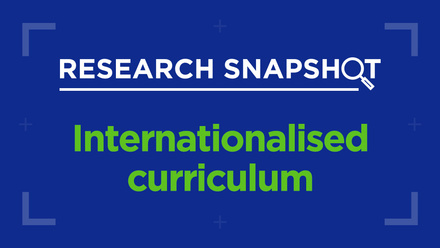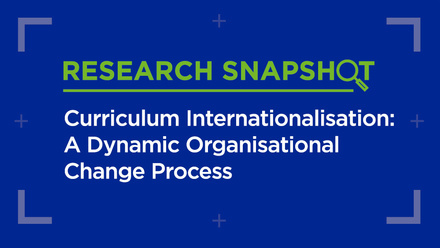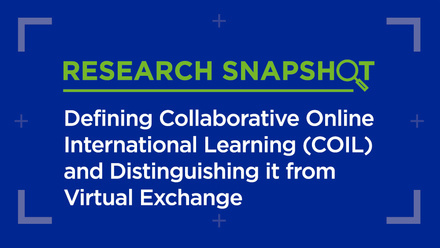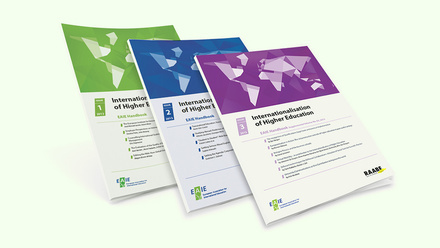Curriculum internationalisation: a process of change

Internationalisation of the curriculum isn’t simply an à la carte addition to your internationalisation strategy – it’s an institution-wide shift that affects stakeholders across the university. When initiating big changes like these, practitioners would be well-served to take some cues from the business world and think in terms of change management.
We start this blog post with a ridiculously obvious proposition – higher education internationalisation is not easy! This is partly attributable to factors such as an institution’s unique mission, its complex structures, the interactions between its resources (fiscal and human), its workforce (academic and professional) and its students. Over three decades of research show this to be true.
Equally challenging in the contemporary context is curriculum internationalisation (CI). While the work of experts in the field such as Leask, Jones, Whitsed and Green and others have highlighted a broad range of challenges and obstacles influencing how CI is realised across institutions, few have drawn attention to the potential of change management research and practices as enablers of and resources for CI.
Curriculum internationalisation is a change process
Writing in the Mediterranean Journal of Social Sciences, Hamdan Said and colleagues (2015) observe that, despite the widely-recognised “need to bring about wider changes to promote quality internationalisation”, “relatively little attention has been paid to the strategies to bring about change”. They argue that there is “a rich literature on organisational change and its importance for successful internationalisation”. We agree!
Our work across multiple institutions reinforces this view. Despite the enthusiasm of individuals and programme-level achievements across disciplines, much of what has been accomplished is fragmented or tangential to the strategic mission of universities. This is despite the rhetoric found in strategic documents and internationalisation plans.
Curriculum internationalisation needs to be interwoven through all the institution’s culture(s) and practices, and this starts with senior leadership and management
In large part, the failure to fully realise institution-wide CI and faculty engagement in this process is attributable to how it has been approached by an institution’s leadership. CI both is and involves a change process, requiring appropriate change management practices and perspectives. The change management literature acknowledges the challenges involved in creating systematic, sustainable change, and provides insights for practitioners applicable to CI.
A case study in change: 5 essential lessons
Universities are multi-layered, hierarchical, dynamic institutions. They are also simultaneously situated in local and global contexts. Further complexity is added when considering that universities are comprised of disparate faculties and disciplines, each often having very different worldviews and thinking about the future. Universities are also often engaged in numerous concurrent educational innovations with each demanding the allocation and distribution of a wide array of resources and assets that often compete against one another. As organisations, universities are also replete with informal networks and power hubs, which add complexity and further complicate the implementation of CI.
The University of Groningen in the Netherlands offers an interesting case study in university-wide CI. Through our participation in the International Classroom Project (2013–2019), we have learnt just how crucial it is to engage with CI as a change process – and we have had successes! A dedicated project team supported by the institution’s leadership and a large budget has contributed to this. However, we have encountered many obstacles, which through the application of change management principles and practices could have been better managed.
Anecdotal evidence like the Groningen case illustrates the complexity of successful institutional change. Our experience has taught us five essential lessons for successful classroom internationalisation.
1. A commitment to CI needs to be communicated and demonstrated
Internationalisation needs to be perceived by staff and students as fundamental to an institution’s purpose, with CI an essential dimension of this vision. It must be integral to its mission and communicated accordingly. A clearly-articulated vision provides direction and incentives. Buy-in is further engendered through a tangible and long-term allocation of resources to build institutional capacity. CI needs to be interwoven through all the institution’s culture(s) and practices, and this starts with senior leadership and management.
2. Identify all stakeholders and engage them from the start
Change management literature stresses the importance of engaging in a process of stakeholder analysis before embarking on institutional change. In addition to identifying a more inclusive range of stakeholders, this step can uncover significant, though often overlooked, patterns of networking critical to the success of the CI process. For example, librarians, student advisors, learning and curriculum designers, learning management technicians and learning technologists who support and/or facilitate the design and delivery of learning are often overlooked.
3. Open the channels for a strategy of consistent, regular and multimodal communication
Internationalisation, like CI, evokes a broad range of understandings and meanings. Both are values and ideologically laden with the potential to arouse vastly contrasting passions. Provision of spaces wherein the free exchange of ideas, understandings and practices is encouraged is essential. Change literature also stresses the importance of institutional communication strategies incorporating multimodal messaging. At Groningen, such a strategy was employed with input from the Central and Internationalisation Offices and faculty, and coordinated by external communication professionals.
4. Acknowledge that CI is a longer-term change process
CI cannot and will not happen overnight, nor is it a process with a definable end-point. Yes – it is possible to set time frames. However, CI involves an ongoing commitment to cycles of curriculum reform and professional development. Framing CI as such helps stakeholders at all levels stay committed over a longer period of time.
5. Be pragmatic!
If experience has taught us anything, it is that it is essential to be pragmatic. A pragmatic approach involves employing a mix of planned, rational, emergent and organic approaches. Go with what works best for the context, stakeholders and stage of CI. Early successes produce a resonance with potential to engage and motivate colleagues who may otherwise be apathetic.
Universities are engaging with CI. That work is advancing. The next challenge is ensuring that institutional approaches to CI are informed by a wider range of research and perspectives. Those working on curriculum internationalisation in their institutions would be well served to take some cues from the business disciplines and change management, as they can offer different lenses and insights into the enablers of and inhibiters to curriculum internationalisation as a process of change.






